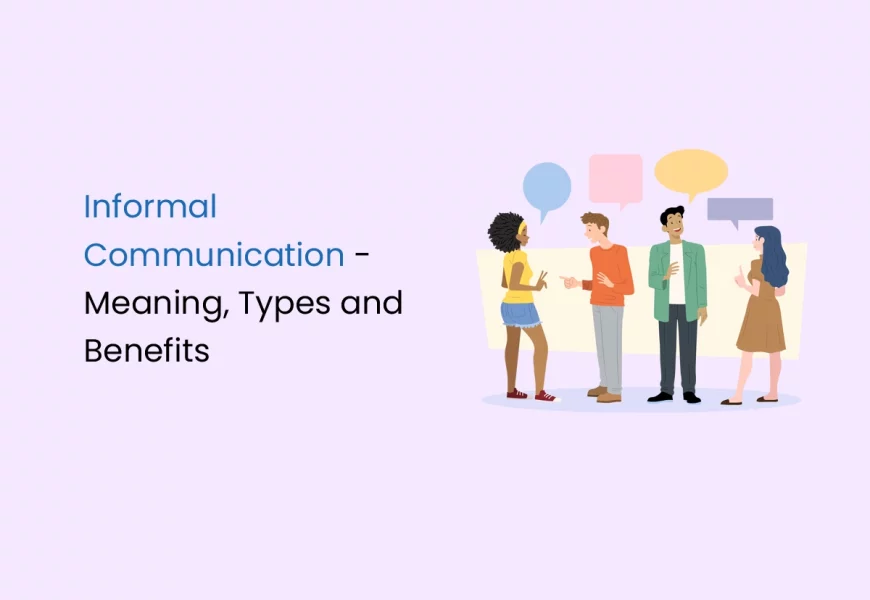In the workplace, informal communication refers to the exchange of ideas, information, and messages between colleagues. This type of communication is vital to any organisation or workplace as it promotes camaraderie, social bonds, and a sense of belonging. Informal communication also helps to strengthen relationships among colleagues, leading to more effective communication, happier employees, and lower turnover rates.
This blog will explore informal communication, its meaning, types and benefits.
What is Informal Communication?
Informal communication is unofficial and takes place between coworkers in a casual setting. These relationships can be formed through shared interests, common goals, or spending time together outside work hours.
Informal communication is essential to workplace culture, as it helps build and maintain positive relationships between coworkers. When employees feel comfortable communicating with one another in an informal setting, they are more likely to feel a sense of belonging and camaraderie, which can lead to increased job satisfaction and productivity. Informal communication can strengthen relationships between coworkers and benefit clients or customers.
In today’s fast-paced work environment, employees often spend a considerable amount of their waking hours in the company of their colleagues. As a result, they tend to develop bonds and relationships that go beyond their work-related interactions. They often engage in small talk and get to know each other personally. This is where the concept of ‘water-cooler talk’ comes in. Water-cooler talk can occur in a physical office setting or virtually on digital platforms. It allows employees to connect with their colleagues personally and build stronger relationships. Engaging in water-cooler talk is a healthy way to break up the monotony of work and build a more positive and collaborative work environment.
Types of Informal Communication
The types of informal communication are as follows:
- Single-Strand Chain: When information is passed sequentially from one person to another, it is called a single-strand chain of communication. In this type of communication, a message is passed from person A to person B, then to person C, and finally, to person D. This type of communication is useful when there is a clear hierarchy or chain of command and clear and concise communication is necessary.
- Gossip Chain: When communicating using a gossip chain, one person shares information with everyone in a group. This type of communication often happens in group discussions and round-table conversations. People share information through gossip, including work updates, rumours, and personal opinions. However, the accuracy of information might vary since it depends on the person sharing it. Although it can be a good way to share information and build relationships in a group, it is essential to remember that the information shared may not always be reliable.
- Probability Chain: Probability chain communication is a way of sharing information randomly among a group of people. One person starts by sharing information and then chooses someone at random in the group to share it with. This process repeats as the person who received the information becomes the new source and shares it with another random person in the group. Because this communication method is random, it is difficult to predict who will receive the information next or how it will spread throughout the group.
- Cluster Chain: When communicating with different groups of people, it can be useful to use a method called cluster chain can be useful. This means that one person shares information with a specific group, who then passes it on to other groups. For example, a manager might use a cluster chain to inform their team about important updates or changes. They would first tell the supervisors, who would then tell their team members. This way, everyone in the team gets the same message without the manager having to talk to each person individually. This method is beneficial in organisations with multiple levels of hierarchy. A cluster chain can make communication more efficient, streamlined, and consistent.
Examples of Informal Communication
Here are some examples of informal communication:
- Casual Conversations: When team members want to discuss work-related issues and communicate with each other on a more personal level, they can have informal discussions during breaks, before and after meetings, or while transitioning between tasks. These conversations help individuals build stronger relationships, share insights and ideas, and address any concerns or challenges hindering their productivity or performance.
- Team Building Activities: Team-building events and activities are a great way for employees to connect and build stronger relationships. These activities can include sports events, brunches, and team outings. They provide a relaxed and fun environment where employees can communicate and bond with each other. Employees can improve their communication skills and build trust by participating in these activities, leading to better collaboration and productivity.
- Collaborative Workspaces: Open office layouts and collaborative workspaces are becoming popular as they encourage interaction and communication between colleagues. These spaces make it easy to share ideas without the need for formal meetings. They offer designated areas for group discussions, brainstorming sessions, and private meetings, providing employees with spaces to work that best suit their needs.
- Social Events: Companies organise social events to help employees connect on a personal level, improving their relationships beyond work. Events include casual outings, formal dinners, charity events, or awards ceremonies. These events help boost morale and create a sense of community in the workplace. They also recognise and reward employees for their hard work and contributions.
- Informal Meetings: When organising a meeting, there are two main types: formal and informal. Informal meetings can happen spontaneously or be scheduled without a specific agenda or structure. They offer a more relaxed environment for team members to share updates, brainstorm ideas, and solve problems. Since informal meetings are less structured, team members can communicate more freely, improving teamwork and creativity. These meetings can occur in various locations, such as coffee shops, break rooms, or outside the office.
- Mentorship and Peer Support: Mentorship and peer support can help employees seek guidance, advice, and feedback from experienced colleagues. These relationships can be formal or informal and are as effective as formal mentorship programs. Employees can develop their skills and navigate workplace challenges by creating these relationships naturally within their teams or departments or through company-sponsored networking events.
- Conversations Over Meals: Many workplaces have an area where employees can eat or have snacks. Often, multiple people can sit together at a table and talk while they eat. This area is usually called a cafeteria. People can also have conversations while they get coffee or water.
- Grapevine Rumour: Grapevine rumours are informal messages that spread through conversations, emails, and instant messages. They often contain inaccurate information and are based on hearsay and gossip. Grapevine rumours can harm morale, productivity, and employee relationships if not corrected. Organisations can prevent grapevine rumours by establishing clear communication channels and promoting open dialogue.
- Virtual Water Cooler: Virtual water coolers are digital spaces where remote employees can chat casually. They’re especially helpful for improving communication and collaboration among remote teams. These spaces are usually created on messaging platforms or other virtual communication tools. Virtual water coolers are like discussion forums where remote workers can share their thoughts and ideas. They’re also a great way to help team members get to know each other better. Team members can discuss their hobbies, families, and interests in these digital spaces.
- Open Door Policy: When managers implement an open-door policy or virtual office hours, it creates a more open and communicative work culture. This allows employees to schedule meetings to discuss work-related issues more informally. These meetings foster a sense of trust and collaboration in the workplace, as employees feel more comfortable discussing their concerns.
- Instant Messaging: Instant messaging platforms like Slack, Microsoft Teams, and Google Chat are great for informal communication in the workplace. They help colleagues stay connected and collaborate efficiently, whether remotely or in different time zones. These platforms are an efficient way to communicate for work-related and non-work-related conversations. They are valuable tools that can increase productivity and foster community among team members.
- Social Media: Social media platforms like Facebook, Twitter, and LinkedIn are valuable tools for companies to connect with colleagues, share news and updates, and promote products or services. Employees can use these platforms to communicate and collaborate, no matter where they are, and foster a sense of community that boosts engagement.
Characteristics of Informal Communication
The characteristics of informal communication in a workplace are as follows:
- Unofficial: Informal communication is generally considered an unofficial communication channel that operates independently of established organisational practices.
- Independent: As the organisation does not control informal communication, it becomes independent and may distort the accuracy of information due to its verbal nature.
- Flexible and Rapid: In informal situations, informal communication is more adaptable and spreads quickly.
- Friendliness: Informal communication fosters a friendly workplace environment and a sense of belonging among employees.
- Multidirectional: Informal communication enables a multidirectional exchange of ideas and opinions among employees.
- Spontaneous: Informal communication allows for spontaneous information flow between individuals of different organisational levels or departments.
Advantages of Informal Communication
The advantages of informal communication in a workplace are as follows:
- Builds Stronger Relationships: People who feel connected to their colleagues are more motivated and engaged at work. Informal communication, such as friendly conversations and team-building activities, can foster community and shared experiences among coworkers. This can benefit employees’ job satisfaction, productivity, and overall well-being. By encouraging these interactions, organisations can help create a strong sense of community in the workplace.
- Promotes Trust and Openness: Employees engaging in casual conversations create an atmosphere of trust and openness, leading to better collaboration and teamwork. Informal communication allows people to connect personally, which can help build stronger relationships and increase job satisfaction. Moreover, informal communication can facilitate knowledge sharing and expertise between colleagues, leading to more informed decision-making and problem-solving.
- Facilitates Knowledge Sharing: Employees who engage in informal communication are likelier to build closer relationships with their colleagues, improving team collaboration and a stronger team spirit. Moreover, informal communication can help to break down organisational silos and encourage knowledge-sharing across different departments or teams. When employees share their experiences and expertise, they can learn from each other and apply new insights to their work, improving processes and outcomes.
- Enhances Innovation: Informal communication often occurs among colleagues outside of scheduled meetings or official channels in a professional setting. These informal conversations can generate fresh and innovative ideas that may not have emerged during structured discussions. This exchange of ideas and perspectives can lead to creative solutions to the organisation’s problems.
- Increases Employee Engagement: Employees who feel part of a supportive and friendly work environment are more likely to be motivated to come to work and perform at their best. This environment helps build stronger relationships and foster a sense of community within the workplace. Research has shown that this connection can increase job satisfaction and lower turnover rates, positively impacting the organisation’s overall success.
- Quick and Effective Communication: Instant messaging is a communication method that allows employees to share information quickly and easily. It enables coworkers to ask questions, share updates, and work together in real-time. Instant messaging is informal and faster than other communication methods like email or phone calls, making it more efficient and productive for employees.
- Flexibility and Adaptability: Informal communication channels are characterised by their flexibility and adaptability to the needs of the individuals involved, making it easier to adjust the communication style based on the context and relationship. The informal nature of these communication channels allows individuals to express their thoughts and feelings more freely, which can help to foster trust, collaboration, and creativity.
Disadvantages of Informal Communication
The disadvantages of informal communication in a workplace are as follows:
- Potential Misunderstandings: Informal communication, such as casual conversation or instant messaging, often lacks the structure and formality of professional communication channels like emails or memos. As a result, there is a greater likelihood of misunderstandings and misinterpretations occurring when information is exchanged through informal means. Moreover, informal communication is often more subjective and can be influenced by the communicators’ personal biases and opinions.
- Rumours and Gossip: Informal communication, such as gossip chains, can significantly source split rumours and unfounded information within a workplace or community. These rumours and false information can create confusion, misunderstandings, and even conflicts among people. Moreover, such disruptions can negatively impact morale, decreasing productivity, low employee engagement, and a toxic work environment.
- Lack of Accountability: When we communicate informally, such as through text messages, social media, or casual conversations, we may not be held accountable for what we say. This can lead to irresponsible or unreliable communication practices. As a result, the information we share may not be accurate or reliable. This can cause harm in personal or professional relationships, create confusion or anxiety, or even cause severe damage in specific contexts.
- Lacks Accuracy: When employees communicate informally, there is a risk of spreading misinformation. This is especially true in large corporations, where rumours can quickly spread and cause anxiety and distrust among workers. Once incorrect information is shared, it can be challenging to correct, leading to conflicts and disruptions in productivity.
- Barrier to Inclusion: Informal communication plays a significant role in building personal connections between colleagues. However, ensuring everyone is included in such communication can be challenging. This is especially true for remote or part-time employees who are often not physically present. They may miss out on the latest news and updates, leading to feelings of exclusion and marginalisation.
Difference between Formal and Informal Communication
Formal communication in a workplace refers to the exchange of official information within the organisation’s established hierarchical structure. This type of communication is typically guided by predetermined policies and procedures that ensure that business processes are efficiently and effectively carried out. Formal communication channels are usually well-defined and have a clear purpose, such as transmitting important information, making decisions, or providing feedback.
On the other hand, informal communication in a workplace does not follow any predetermined rules or policies. It is the exact opposite of formal communication. Informal communication channels are less structured and more relaxed and are often used for casual conversations, sharing personal information, or building colleague relationships. Informal communication can take place between individuals or groups, and it can be either verbal or non-verbal.
When differentiating between formal and informal business communication, it is essential to note that the distinction is not always clear-cut. Instead, it is primarily based on whether the communication is defined by the business structure and its set communication rules or whether it is casual or professional. In some cases, the lines between formal and informal communication may blur. Once informal communication channels can become formalised over time as they are used more frequently.
Importance of Informal Communication
The importance of informal communication in an organisation is as follows:
- Enhances Employee Engagement: When employees feel at ease to share their thoughts and opinions freely, they are more likely to actively participate in discussions, share innovative ideas, and contribute their unique skills and perspectives to the organisation’s goals. This open communication fosters a collaborative and inclusive workplace culture, increasing productivity, better problem-solving, and employee satisfaction.
- Foster Team Spirit: When people communicate informally at work, it can help build trust and friendship among colleagues, creating a more positive atmosphere and encouraging teamwork. When people feel they belong, they are likelier to work well together. Informal communication can help people feel more comfortable sharing their thoughts and ideas. This can lead to better productivity, motivation, and job satisfaction. Informal communication can also help people from different departments or levels feel more connected. When people feel connected, they are more likely to work together as a team.
- Encourages Open Dialogue: Employees can have more open and honest discussions when communicating informally. They may feel less restricted by formalities and hierarchies, making expressing their thoughts and concerns easier. Many employees prefer informal communication because it provides a more relaxed atmosphere that encourages individuals to speak up about their opinions and ideas.
- Supports Knowledge Sharing: When employees communicate informally, they can share knowledge and best practices to help each other develop professionally and better understand their organisation. This learning can have a positive impact on productivity and efficiency, as well as foster collaboration and innovation among colleagues.
- Strengthens Relationships with Leadership: Organisations promoting informal communication among employees and their leaders can help bridge the gap between them. Informal conversations can be an effective way for employees to build closer relationships with their leaders, leading to a more approachable and open work culture. This type of communication can foster a sense of trust and collaboration and encourage employees to share their ideas, concerns, and feedback more freely.
- Boosts Employee Morale: Informal communication is essential to any workplace, allowing employees to connect personally. It fosters a sense of camaraderie among coworkers and helps boost morale, celebrate successes, and acknowledge achievements. When employees can freely communicate with one another, it creates a positive and motivating work environment that promotes confidence and enhances teamwork. Furthermore, informal communication allows employees to offer positive feedback and constructive criticism, improving overall job performance and productivity.
How to Use Informal Communication Effectively
The following strategies can help use informal communication effectively:
- Recognising and Valuing Informal Channels: It is essential to recognise the significance of informal communication in promoting collaboration and building relationships. Casual conversations, small talk, and non-work-related discussions help team members establish trust and rapport and create a supportive work environment. Dismissing these informal exchanges as unimportant can hinder a cohesive team culture. Leaders or team members should encourage informal communication to create a more productive and collaborative environment where everyone feels valued and supported.
- Balancing Formal and Informal Communication: While informal communication can be a good way to build relationships and foster collaboration, it’s important to remember that it shouldn’t replace formal communication channels, especially when sharing critical information. Formal communication provides a structure that ensures accuracy and clarity, allowing for essential details to be documented and easily referenced. To maintain transparency and accountability, it’s necessary to balance informal and formal communication and use each channel appropriately based on the context and purpose of the message.
- Using Technology Wisely: One of the most effective ways to enhance informal communication is by leveraging various technological tools and platforms. Instant messaging platforms like Slack, Microsoft Teams, or Google Chat allow team members to communicate in real time, share ideas, and keep each other informed about ongoing projects. Finally, social media groups like Facebook, LinkedIn, or Twitter can foster informal communication and build stronger relationships among team members. By utilising these technologies, teams can streamline communication processes, boost productivity, and achieve their goals more effectively.
- Encouraging Face-to-Face Interactions: In today’s fast-paced world, technology has become an integral part of our lives, helping us stay connected with people across the globe and making our lives easier in many ways. However, while technology is valuable, it should never replace the value of face-to-face interactions. In-person communication allows for non-verbal cues such as facial expressions, body language, and tone of voice, which are crucial for effective communication. Moreover, it helps to build and maintain relationships, which are essential for personal and professional growth.
- Setting Clear Communication Expectations: Establish clear and definable boundaries between informal and formal communication channels. Additionally, providing guidelines on when it is appropriate to use informal channels versus formal channels can be helpful. This can help prevent confusion and misunderstandings between team members and ensure that communication is streamlined and effective.
Conclusion
Informal communication is vital in organisations because it promotes collaboration, creativity, and camaraderie. Although formal channels are essential for conveying official information, informal exchanges are crucial in developing meaningful relationships and driving engagement. By acknowledging the significance of informal communication and encouraging an environment where it can flourish, organisations can release the full potential of their workforce and build a culture of transparency, innovation, and collaboration.
Frequently Asked Questions
What is the best example of informal communication?
Informal communication includes casual chats, water cooler catch-ups, and office gossip.
What are the advantages of informal communication?
Informal communication fosters trust, enables efficient problem-solving, encourages open dialogue, builds relationships, and allows quick adaptation.
What is the difference between formal and informal communication?
Formal communication involves exchanging information in an organised, official, and intentional manner within a professional or organisational setting. Informal communication, on the other hand, refers to the spontaneous, casual, and unofficial exchange of information that occurs in social or personal interactions.
What is the disadvantage of informal communication?
The informal communication network has limitations such as incomplete information, lack of secrecy, security and rules.
What are the characteristics of informal communication?
The characteristics of informal communication in a workplace are as follows:
- It is not professional.
- It doesn’t use official channels.
- It uses friendly language.
- It helps build relationships and makes social interactions easier.
- It is casual and spontaneous.
- It is flexible, adaptive, and dynamic.
- It doesn't have a specific structure.
- There's no clear chain of command.





















